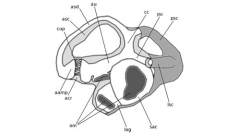

 Comptes Rendus Palevol
9 (6-7) - Pages 397-410
Comptes Rendus Palevol
9 (6-7) - Pages 397-410The vestibular system detects head movement in space and maintains visual and postural stability. The semicircular canal system is responsible for registering head rotation. How it responds to head rotation is determined by the rotational axis and the angular acceleration of the head, as well as the sensitivity and orientation of each semicircular canal. The morphological parameters of the semicircular canals are supposed to allow an optimal detection of head rotations induced by some behaviours, especially locomotor. We propose a new method of semicircular canal analysis, based on the computation of central streamlines of virtually reconstructed labyrinths. This method allows us to ascertain the functional structure of the semicircular canal system and to infer its capacity to detect particular head rotations, induced by particular behaviours. In addition, this method is well-suited for datasets provided by any kind of serial sectioning methods, from MRI to μCT scanning and even mechanical serial sectioning, of extant and extinct taxa.
Behaviour, Central streamline, Functional structure, Geometric morphometry, Locomotion, Semicircular canal, Total response